|
Modal
Characteristics of Antiresonant
Reflecting Pipe Waveguides for Terahertz
Waveguiding
Professor Hung-chun
Chang
Graduate Institute of Photonics and
Optoelectronics, National Taiwan
University
台湾大学光电所 张宏钧教授
The
pipe waveguide, which is a thin pipe
consisting of a large air core and a
thin dielectric layer with uniform but
low index, is promising for THz
waveguiding owing to its low-loss
feature and simple structure. In this
research, modal characteristics of the
leaky core modes of the pipe waveguide
are investigated in the THz range.
Utilizing the finite-difference
frequency-domain (FDFD) mode solver,
modal indices and attenuation constants
of the core modes which are frequency
dependent are calculated for different
core diameters, cladding thicknesses,
and cladding refractive indices. It is
found that at certain frequencies no
core modes can exist. Comparing these
frequencies with the resonant
frequencies of the cladding reveals that
the guiding mechanism of the core modes
is that of the antiresonant reflecting
guiding. Calculated results also suggest
that, to have a low-loss and
high-bandwidth pipe waveguide, large
core diameter, thin cladding thickness,
and low refractive index are desired.
The effect of material absorption is
also examined, which shows that the
attenuation constant magnitude will be
increased and the increment is more
significant at higher frequencies.
Moreover, modal patterns are shown for
the fundamental mode and the higher
order modes, including modal intensity
distributions and electric field vector
distributions. It is observed that modal
patterns of the core modes of the pipe
waveguide resemble those of the guided
modes of the step-index fiber. From the
spectrum of the attenuation constant, it
shows that the fundamental mode (HE11-like)
has the smallest attenuation constant
and is the dominant mode for the pipe
waveguide investigated. (Optics
Express, vol. 18, no. 1, pp.
309–322, 5 January 2010.)
|
 |
|
Fig. 1. (a)
Cross-section of the pipe waveguide,
where n1 = 1 (air).
(b) The cladding can be viewed as a
Fabry-Perot etalon. |
|
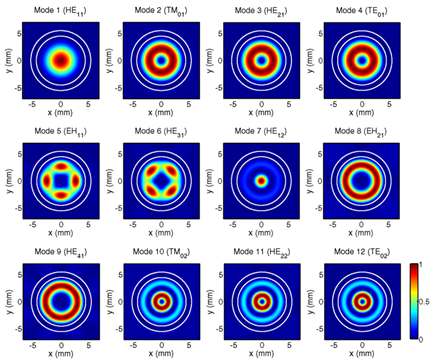 |
|
Fig. 2. Modal
intensity distributions of the first
twelve lowest modes of the pipe
waveguide at 380GHz. The parameters of
the pipe waveguide are: core diameter
D = 9 mm, cladding thickness t
= 1 mm, and cladding refractive index
n2 = 1.4. |
|
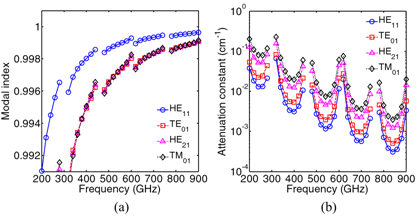 |
|
Fig. 3. (a)
Modal indices and (b) attenuation
constants of the fundamental mode and
the first set of higher order modes of
the pipe waveguide. |
Fabrication of Sphere-like Au
Nanoparticles with Laser Irradiation for
Localized Surface Plasmon Resonance
Applications
Professor
C. C. Yang’s
Laboratory
Graduate Institute of Photonics and
Optoelectronics, National Taiwan
University
台湾大学光电所 杨志忠教授
We have
demonstrated a simple method for
fabricating substrate adhesive Au
nanoparticles (NPs) of no aggregation
based on a process of laser ablation and
annealing. The size, shape, surface
density, and coverage of Au NPs on a
substrate can be controlled by laser
energy density, substrate material and
surface condition, deposited Au film
thickness, and the liquid covering the
Au film during laser irradiation. With
optical transmission measurements, the
in-plane and out-of-plane localized
surface plasmon resonance (LSPR)
features can be clearly identified due
to the similar shapes and vertical
alignments of NPs on substrate. The
spectral features of substrate-affected
LSPR modes rely on the size,
Au/substrate contact area, substrate
material, and surrounding gas or liquid.
Numerical simulations based on the
finite-element method show highly
consistent results in the LSPR-induced
extinction spectral features. Fig. 1 and
2 show the plan- and tilted-view SEM
images of Au NPs on a sapphire
substrate. Fig. 3 shows the transmission
spectra of Au NPs on sapphire and SiO2
demonstrating the LSPR features. For
details, please read the publication: C.
Y. Chen et al., Optics Express 17,
14186 (2009).
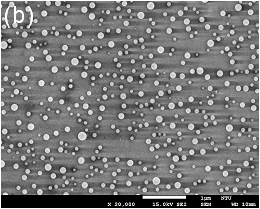 |
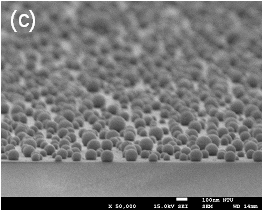 |
|
Fig. 1.
Plan-view SEM image of Au NPs. |
Fig. 2.
Tilted-view SEM image of Au NPs. |
|
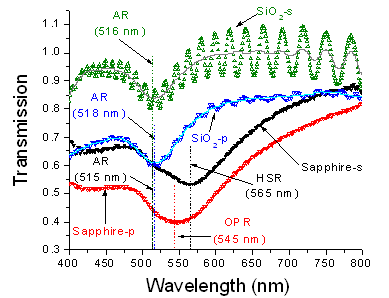 |
|
Fig. 3. Transmission
spectra of Au NPs on sapphire and SiO2
substrates. |
|